英语演讲教案课程
大学英语演讲教案

教学目标:1. 帮助学生了解演讲的基本结构和技巧。
2. 培养学生的自信心和演讲能力。
3. 提高学生的英语口语表达水平。
教学对象:大学英语专业或英语爱好者教学时长:2课时教学准备:1. 演讲稿示例2. 演讲技巧视频3. 小组讨论话题4. 演讲评分标准教学过程:第一课时:一、导入1. 向学生介绍本次课程的主题:大学英语演讲技巧培训。
2. 提问:大家认为演讲的重要性体现在哪些方面?二、演讲的基本结构1. 向学生讲解演讲的三个基本部分:引言、主体和结论。
2. 通过PPT展示演讲稿的示例,分析每个部分的特点和作用。
三、演讲技巧讲解1. 语速与语调:讲解语速和语调在演讲中的重要性,展示不同语速和语调的演讲效果。
2. 语音与语流:强调语音清晰、语流顺畅对演讲的影响。
3. 肢体语言:讲解肢体语言在演讲中的作用,如手势、眼神交流等。
4. 情感表达:分享如何运用情感使演讲更具感染力。
四、小组讨论1. 将学生分成小组,讨论以下话题:- 如何克服演讲时的紧张情绪?- 如何使演讲更具说服力?- 如何提高自己的演讲技巧?五、演讲技巧视频观看1. 播放一段优秀的演讲视频,让学生分析演讲者的技巧和优点。
第二课时:一、复习上节课的内容1. 回顾演讲的基本结构和技巧。
2. 询问学生对上节课内容的理解和掌握情况。
二、模拟演讲练习1. 学生分组进行模拟演讲,每组选出一个演讲者。
2. 演讲者根据上节课所学内容,准备一段演讲稿。
3. 小组成员对演讲者进行评价,指出优点和不足。
三、演讲技巧点评1. 邀请一位学生进行演讲,其他学生和教师对其演讲技巧进行点评。
2. 点评内容包括:语速、语调、语音、语流、肢体语言、情感表达等方面。
四、总结与反思1. 教师总结本次课程的重点内容,强调演讲技巧的重要性。
2. 学生分享自己在演讲过程中的收获和感悟。
教学评价:1. 学生对演讲技巧的理解程度。
2. 学生在模拟演讲中的表现。
3. 学生对课程内容的反馈意见。
教学反思:1. 教师应关注学生的个体差异,针对不同学生制定相应的教学策略。
大学公共英语演讲课教案
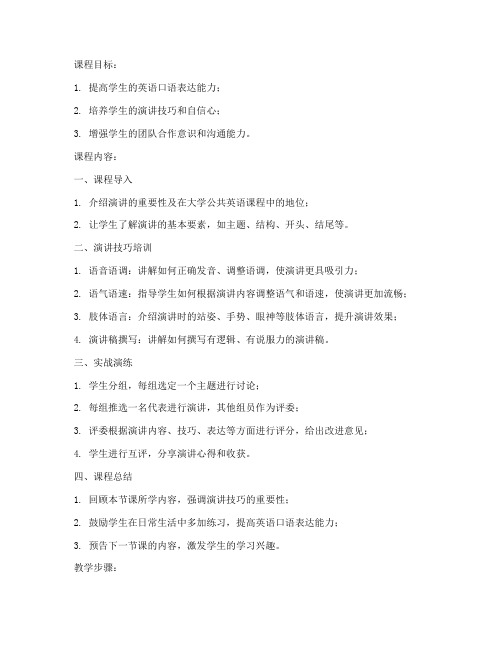
课程目标:1. 提高学生的英语口语表达能力;2. 培养学生的演讲技巧和自信心;3. 增强学生的团队合作意识和沟通能力。
课程内容:一、课程导入1. 介绍演讲的重要性及在大学公共英语课程中的地位;2. 让学生了解演讲的基本要素,如主题、结构、开头、结尾等。
二、演讲技巧培训1. 语音语调:讲解如何正确发音、调整语调,使演讲更具吸引力;2. 语气语速:指导学生如何根据演讲内容调整语气和语速,使演讲更加流畅;3. 肢体语言:介绍演讲时的站姿、手势、眼神等肢体语言,提升演讲效果;4. 演讲稿撰写:讲解如何撰写有逻辑、有说服力的演讲稿。
三、实战演练1. 学生分组,每组选定一个主题进行讨论;2. 每组推选一名代表进行演讲,其他组员作为评委;3. 评委根据演讲内容、技巧、表达等方面进行评分,给出改进意见;4. 学生进行互评,分享演讲心得和收获。
四、课程总结1. 回顾本节课所学内容,强调演讲技巧的重要性;2. 鼓励学生在日常生活中多加练习,提高英语口语表达能力;3. 预告下一节课的内容,激发学生的学习兴趣。
教学步骤:1. 导入课程:用简短的英语演讲,引导学生关注演讲的重要性,激发他们的学习兴趣。
2. 讲解演讲技巧:通过PPT展示,详细讲解演讲技巧,包括语音语调、语气语速、肢体语言和演讲稿撰写等方面。
3. 实战演练:将学生分成若干小组,每组选定一个主题进行讨论,然后推选一名代表进行演讲。
教师巡回指导,帮助学生克服演讲中的困难。
4. 评委点评:邀请学生担任评委,对演讲者的表现进行评分和点评,提出改进意见。
5. 互评环节:学生之间互相评价,分享演讲心得和收获。
6. 课程总结:回顾本节课所学内容,强调演讲技巧的重要性,并鼓励学生在日常生活中多加练习。
教学资源:1. PPT课件:包括演讲技巧、案例分析等内容;2. 演讲稿模板:提供不同主题的演讲稿模板,帮助学生撰写演讲稿;3. 演讲视频:选取优秀的英语演讲视频,供学生参考学习。
大学生英语演讲课教案
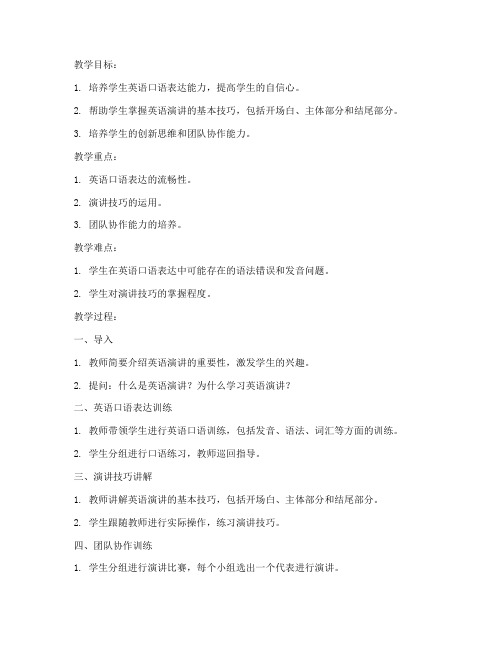
教学目标:1. 培养学生英语口语表达能力,提高学生的自信心。
2. 帮助学生掌握英语演讲的基本技巧,包括开场白、主体部分和结尾部分。
3. 培养学生的创新思维和团队协作能力。
教学重点:1. 英语口语表达的流畅性。
2. 演讲技巧的运用。
3. 团队协作能力的培养。
教学难点:1. 学生在英语口语表达中可能存在的语法错误和发音问题。
2. 学生对演讲技巧的掌握程度。
教学过程:一、导入1. 教师简要介绍英语演讲的重要性,激发学生的兴趣。
2. 提问:什么是英语演讲?为什么学习英语演讲?二、英语口语表达训练1. 教师带领学生进行英语口语训练,包括发音、语法、词汇等方面的训练。
2. 学生分组进行口语练习,教师巡回指导。
三、演讲技巧讲解1. 教师讲解英语演讲的基本技巧,包括开场白、主体部分和结尾部分。
2. 学生跟随教师进行实际操作,练习演讲技巧。
四、团队协作训练1. 学生分组进行演讲比赛,每个小组选出一个代表进行演讲。
2. 教师组织学生进行评价和讨论,培养学生的团队协作能力。
五、课堂小结1. 教师总结本节课的学习内容,强调重点和难点。
2. 学生分享学习心得,提出疑问。
六、课后作业1. 学生准备一篇英语演讲稿,内容自选。
2. 学生在家练习英语口语表达,提高发音和语法水平。
教学评价:1. 课堂参与度:观察学生在课堂上的发言次数和积极性。
2. 口语表达能力:评价学生在课堂上的口语表达流畅程度和准确性。
3. 演讲技巧运用:评价学生在演讲比赛中的技巧运用情况。
4. 团队协作能力:评价学生在小组活动中的合作精神和团队意识。
教学反思:1. 教师在课堂上要注意观察学生的反应,及时调整教学策略。
2. 注重培养学生的自信心,鼓励学生积极参与课堂活动。
3. 加强对学生的个别辅导,关注学生的发音和语法问题。
4. 课后及时批改学生的作业,了解学生的学习情况。
课前英语演讲技巧教案中班
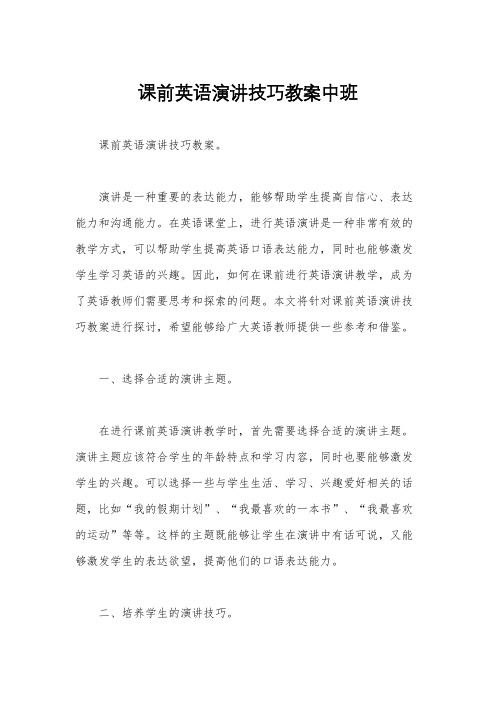
课前英语演讲技巧教案中班课前英语演讲技巧教案。
演讲是一种重要的表达能力,能够帮助学生提高自信心、表达能力和沟通能力。
在英语课堂上,进行英语演讲是一种非常有效的教学方式,可以帮助学生提高英语口语表达能力,同时也能够激发学生学习英语的兴趣。
因此,如何在课前进行英语演讲教学,成为了英语教师们需要思考和探索的问题。
本文将针对课前英语演讲技巧教案进行探讨,希望能够给广大英语教师提供一些参考和借鉴。
一、选择合适的演讲主题。
在进行课前英语演讲教学时,首先需要选择合适的演讲主题。
演讲主题应该符合学生的年龄特点和学习内容,同时也要能够激发学生的兴趣。
可以选择一些与学生生活、学习、兴趣爱好相关的话题,比如“我的假期计划”、“我最喜欢的一本书”、“我最喜欢的运动”等等。
这样的主题既能够让学生在演讲中有话可说,又能够激发学生的表达欲望,提高他们的口语表达能力。
二、培养学生的演讲技巧。
在进行课前英语演讲教学时,还需要培养学生的演讲技巧。
演讲技巧包括语言表达、肢体语言、声音语调等方面。
首先,学生要能够清晰、流利地表达自己的观点和想法,因此需要不断地进行口语训练,提高学生的口语表达能力。
其次,学生还需要学会运用肢体语言来增强演讲的表现力,比如眼神交流、手势运用等。
最后,学生还需要注意声音语调的运用,要能够根据演讲内容的不同来调整语调,让演讲更加生动有趣。
三、提供充分的演讲准备时间。
在进行课前英语演讲教学时,还需要给学生充分的演讲准备时间。
学生可以在课前准备好演讲稿,然后进行反复练习,直到能够熟练、流利地表达。
同时,学生还可以进行一些小组讨论或者角色扮演,来提高演讲的真实感和表现力。
在准备过程中,老师可以给予一些指导和建议,帮助学生不断改进演讲内容和表达方式。
四、提供积极的演讲环境。
在进行课前英语演讲教学时,还需要提供一个积极的演讲环境。
老师可以在课堂上进行一些示范演讲,让学生能够从中学习到一些演讲技巧和经验。
同时,老师还可以鼓励学生积极参与演讲,给予肯定和鼓励,让学生能够在一个轻松、愉快的氛围中进行演讲,提高他们的自信心和表达欲望。
英语演讲课程教案

英语演讲课程教案一、课程简介二、教学目标1. 提高学生的英语口语表达能力。
2. 培养学生的演讲技巧和自信心。
3. 帮助学生掌握演讲的基本结构和技巧。
4. 提高学生的公众演讲能力。
三、教学内容1. 演讲的基本概念和重要性。
2. 演讲的准备和计划。
3. 演讲的开头和结尾。
4. 演讲中的语言表达和肢体语言。
5. 演讲的练习和反馈。
四、教学方法1. 讲授法:讲解演讲的基本概念、技巧和注意事项。
2. 实践法:学生进行演讲练习,教师进行指导和反馈。
3. 小组讨论法:学生分组讨论演讲相关话题,分享经验和意见。
4. 观摩法:观看优秀演讲视频,学习借鉴先进的演讲技巧。
五、教学评价1. 平时练习:对学生平时的演讲练习进行评价,关注口语表达能力、演讲技巧和自信心等方面。
2. 课堂表现:评价学生在课堂上的参与程度、合作能力和进步情况。
3. 演讲比赛:组织学生参加演讲比赛,评价演讲内容、语言表达和现场表现等方面。
4. 学生互评:鼓励学生互相评价,共同提高演讲能力。
六、教学准备1. 教材:选用适合英语演讲的课程教材,如《英语演讲艺术》等。
2. 辅助材料:提供相关的演讲范文、优秀演讲视频等资源。
3. 投影仪、音响等教学设备:用于展示PPT和播放视频材料。
4. 讲台和座位:布置合适的演讲场地。
七、教学安排1. 课时:本课程共安排16课时,每课时45分钟。
2. 课程进度:按照教学内容进行有序教学,确保每个话题都有足够的练习时间。
3. 课堂活动:结合教学内容,安排不同的课堂活动,如演讲练习、讨论等。
八、教学反思2. 关注学生的学习反馈,及时调整教学内容和难度,满足学生的学习需求。
3. 关注学生的个体差异,给予不同的学生个性化的指导和支持。
九、教学拓展1. 组织学生参加校内外英语演讲比赛,提高学生的实战能力。
2. 邀请专业英语演讲教练进行讲座或辅导,拓宽学生的视野。
3. 引导学生参加英语角等活动,增加学生的英语实践机会。
3. 对学生提出建议和期望,鼓励他们在未来的学习和生活中运用所学,不断提高自己的英语演讲能力。
英语演讲选修课教案informativespeech I
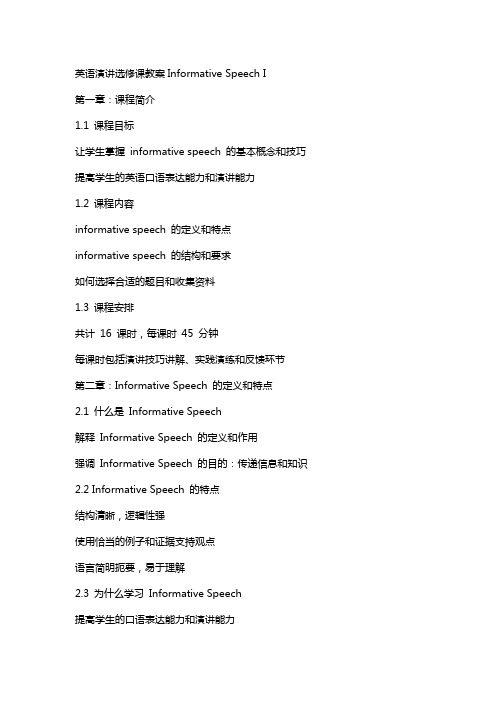
英语演讲选修课教案Informative Speech I第一章:课程简介1.1 课程目标让学生掌握informative speech 的基本概念和技巧提高学生的英语口语表达能力和演讲能力1.2 课程内容informative speech 的定义和特点informative speech 的结构和要求如何选择合适的题目和收集资料1.3 课程安排共计16 课时,每课时45 分钟每课时包括演讲技巧讲解、实践演练和反馈环节第二章:Informative Speech 的定义和特点2.1 什么是Informative Speech解释Informative Speech 的定义和作用强调Informative Speech 的目的:传递信息和知识2.2 Informative Speech 的特点结构清晰,逻辑性强使用恰当的例子和证据支持观点语言简明扼要,易于理解2.3 为什么学习Informative Speech提高学生的口语表达能力和演讲能力培养学生的研究和批判性思维能力增强学生的自信心和公众演讲技巧第三章:Informative Speech 的结构和要求3.1 结构概述引言:吸引听众的注意力,提出主题阐述主题,提供相关信息和支持论据结尾:总结全文,强调重点,提出建议或号召3.2 引言部分开头句:吸引听众的注意力,与主题相关背景信息:介绍话题的背景和重要性主题句:明确提出要传递的信息或知识3.3 部分段落结构:每段只包含一个主要观点论据支持:使用事实、数据、例子等支持观点过渡句:连接各个段落,保持演讲的连贯性3.4 结尾部分总结全文:回顾主要观点和论据强调重点:突出重要信息和观点提出建议或号召:引导听众采取行动或思考问题第四章:如何选择合适的题目和收集资料4.1 选择题目的原则个人兴趣和热情:选择自己感兴趣的话题知识储备:选择自己熟悉或有所了解的话题听众需求:考虑听众的兴趣和需求4.2 收集资料的方法图书馆研究:查阅相关书籍、杂志和期刊网络搜索:利用互联网资源进行资料收集采访专家:请教专业人士的意见和见解4.3 资料整理和筛选整理收集到的资料,分类别和关键词评估资料的可信度和可靠性筛选出与演讲主题相关的重要资料第五章:演讲技巧讲解与实践5.1 演讲技巧讲解声音与语调:保持声音的清晰和语调的抑扬顿挫肢体语言:运用合适的肢体动作表达观点和情感时间控制:掌握演讲的时间,避免超时或拖延5.2 实践演练分组练习:学生分组进行演讲练习,互相观摩和反馈角色扮演:模拟演讲场景,进行角色扮演和演讲练习录音反馈:学生录制自己的演讲,回放听取并进行自我评价5.3 反馈环节学生互相评价:给予同学演讲的反馈和建议教师评价:教师对学生的演讲进行评价和指导改进和提升:根据反馈意见进行改进,提升演讲技巧第六章:演讲的开头和结尾技巧6.1 开头技巧钩子:用一个有趣的故事、引用或问题吸引听众的注意力相关性:解释演讲与听众的关联,激发听众的兴趣定义:简洁明了地定义演讲主题,为后续内容做铺垫6.2 结尾技巧总结:回顾演讲的主要观点,强化听众的记忆呼吁行动:鼓励听众采取具体行动或思考问题留下悬念:提出一个引发思考的问题,为后续讨论提供话题第七章:使用视觉辅助材料7.1 视觉辅助材料的作用增强演讲的吸引力:通过图片、图表等视觉元素吸引听众的注意力辅助说明:用视觉材料展示数据、流程或概念,使内容更清晰易懂提高记忆:视觉元素有助于听众更好地记忆和理解演讲内容7.2 选择合适的视觉辅助材料图片:选用与演讲主题相关的图片,简洁明了地表达观点图表:用图表展示数据和趋势,使信息更直观易懂幻灯片:制作简洁清晰的幻灯片,辅助说明演讲内容7.3 使用视觉辅助材料的注意事项视觉元素与演讲内容紧密结合,避免无关或过多的装饰确保视觉辅助材料清晰可见,避免文字过小或颜色过于刺眼适时展示视觉辅助材料,与演讲内容同步,避免中断演讲流程第八章:处理紧张和失误8.1 认识紧张和失误紧张:面对听众时的自然情绪反应,影响演讲的表现失误:演讲过程中出现的口误、忘词等情况8.2 应对紧张的策略深呼吸:通过深呼吸放松身体和心情积极心态:调整心态,相信自己的准备和能力模拟练习:提前进行模拟练习,增加对演讲场景的熟悉度8.3 应对失误的策略镇定处理:保持镇定,不要慌张,继续演讲巧妙转移:用幽默或灵活的语言转移听众注意力补救措施:如果忘词,可以简要回顾上文内容,或借助视觉辅助材料提示第九章:演讲的语音语调与表达9.1 语音语调的重要性语音:清晰准确地发音,增强语言的感染力语调:适当的抑扬顿挫,使演讲更具表现力9.2 练习发音和语调模仿训练:模仿优秀演讲者的发音和语调,提高自己的表达能力录音反馈:录下自己的演讲,回放听评,改进发音和语调注重语流:保持语言的连贯性,避免生硬或过度的停顿9.3 增强表达力使用修辞手法:运用比喻、排比等修辞手法,丰富语言表达适当运用感叹词和语气词:增强语言的情感色彩关注听众反应:根据听众的反应调整语气和表达方式第十章:演讲的评估与自我提升10.1 评估标准内容:是否完整、准确地传达了信息结构:演讲是否条理清晰、逻辑严密表达:语音语调、肢体语言是否恰当,富有感染力互动:与听众的眼神交流、提问等互动是否自然顺畅10.2 自我提升策略反思总结:每次演讲后,进行自我反思和总结,找出不足之处持续练习:定期进行演讲练习,不断提高自己的表达能力学习借鉴:观看优秀演讲者的演讲视频,学习他们的经验和技巧10.3 寻求反馈和建议向同学、老师或其他听众寻求反馈,了解自己的演讲表现根据反馈意见进行改进,提升自己的演讲能力重点和难点解析1. Informative Speech 的结构和要求:理解并掌握informative speech 的基本结构,包括引言、和结尾,以及每个部分的功能和写作要求。
少儿英语-演讲与口才教案
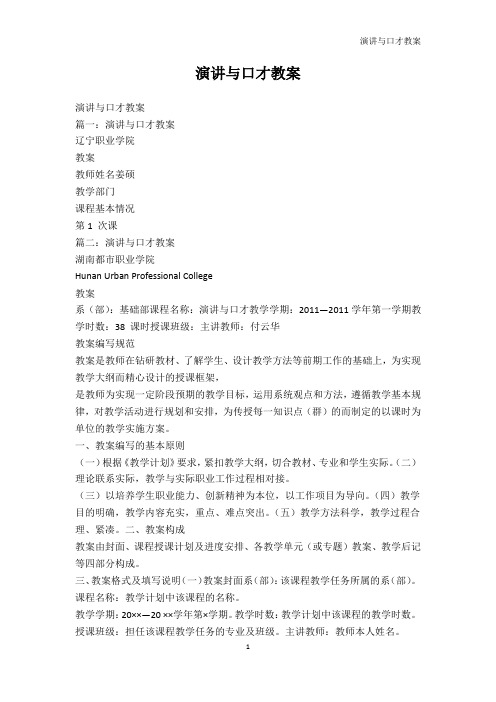
演讲与口才教案演讲与口才教案篇一:演讲与口才教案辽宁职业学院教案教师姓名姜硕教学部门课程基本情况第1 次课篇二:演讲与口才教案湖南都市职业学院Hunan Urban Professional College教案系(部):基础部课程名称:演讲与口才教学学期:2011—2011学年第一学期教学时数:38 课时授课班级:主讲教师:付云华教案编写规范教案是教师在钻研教材、了解学生、设计教学方法等前期工作的基础上,为实现教学大纲而精心设计的授课框架,是教师为实现一定阶段预期的教学目标,运用系统观点和方法,遵循教学基本规律,对教学活动进行规划和安排,为传授每一知识点(群)的而制定的以课时为单位的教学实施方案。
一、教案编写的基本原则(一)根据《教学计划》要求,紧扣教学大纲,切合教材、专业和学生实际。
(二)理论联系实际,教学与实际职业工作过程相对接。
(三)以培养学生职业能力、创新精神为本位,以工作项目为导向。
(四)教学目的明确,教学内容充实,重点、难点突出。
(五)教学方法科学,教学过程合理、紧凑。
二、教案构成教案由封面、课程授课计划及进度安排、各教学单元(或专题)教案、教学后记等四部分构成。
三、教案格式及填写说明(一)教案封面系(部):该课程教学任务所属的系(部)。
课程名称:教学计划中该课程的名称。
教学学期:20××—20 ××学年第×学期。
教学时数:教学计划中该课程的教学时数。
授课班级:担任该课程教学任务的专业及班级。
主讲教师:教师本人姓名。
(二)课程授课计划及课程授课进度安排教师制定并经该课程教学任务所属的系(部)批准的学期授课计划。
分为课程授课计划与课程授课进度安排两部分:1、课程授课计划:课程名称,教学学期,授课班级,课程教学总时数、理论教学时数、实践教学时数,课程教学所对接的职业工作与其职业能力要求,教学目标,教学重点、难点及其突破方法。
教学支撑环境与教学资源,主要教学方法与手段,学生学习成绩考核与评价办法等。
中学生英语演讲教案
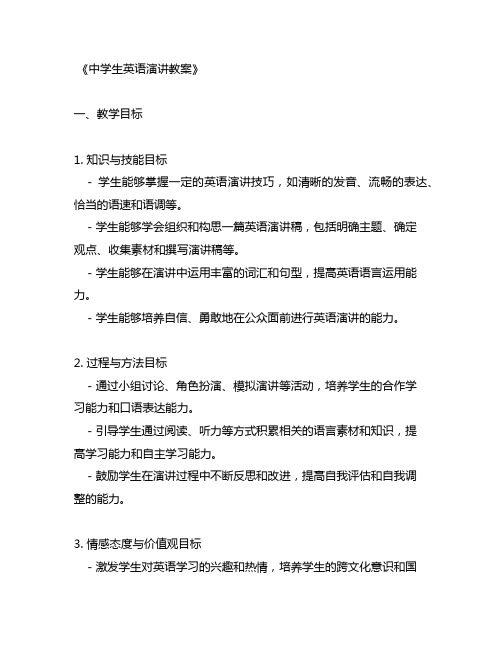
《中学生英语演讲教案》一、教学目标1. 知识与技能目标- 学生能够掌握一定的英语演讲技巧,如清晰的发音、流畅的表达、恰当的语速和语调等。
- 学生能够学会组织和构思一篇英语演讲稿,包括明确主题、确定观点、收集素材和撰写演讲稿等。
- 学生能够在演讲中运用丰富的词汇和句型,提高英语语言运用能力。
- 学生能够培养自信、勇敢地在公众面前进行英语演讲的能力。
2. 过程与方法目标- 通过小组讨论、角色扮演、模拟演讲等活动,培养学生的合作学习能力和口语表达能力。
- 引导学生通过阅读、听力等方式积累相关的语言素材和知识,提高学习能力和自主学习能力。
- 鼓励学生在演讲过程中不断反思和改进,提高自我评估和自我调整的能力。
3. 情感态度与价值观目标- 激发学生对英语学习的兴趣和热情,培养学生的跨文化意识和国际视野。
- 增强学生的自信心和自尊心,培养学生勇于表达自己观点和想法的精神。
- 通过演讲活动,培养学生的团队合作意识和竞争意识。
二、教学重难点1. 教学重点- 英语演讲技巧的训练,如发音、表达、语速语调等。
- 演讲稿的撰写和组织,包括主题的确定、观点的阐述、素材的收集等。
- 学生在演讲中的自信和流利表达能力的培养。
2. 教学难点- 如何引导学生克服紧张情绪,在公众面前自信地进行演讲。
- 如何提高学生的英语语言表达能力,使演讲稿更加生动、有趣、富有感染力。
- 如何培养学生的批判性思维和创新能力,使演讲内容具有独特性和深度。
三、教学方法1. 讲授法- 讲解英语演讲的基本知识和技巧,如发音、表达、语速语调等。
- 分析优秀英语演讲稿的特点和写作方法,为学生提供范例和指导。
2. 演示法- 教师进行示范演讲,展示正确的发音、表达和演讲技巧,让学生直观感受。
- 播放优秀的英语演讲视瓶,让学生学习借鉴他人的优点。
3. 练习法- 组织学生进行小组讨论、角色扮演、模拟演讲等活动,让学生在实践中提高演讲能力。
- 布置演讲稿撰写和演讲练习任务,让学生通过反复练习巩固所学知识和技能。
中班爱国英文演讲稿教案

教学目标:1. 培养幼儿对祖国的热爱之情,增强民族自豪感。
2. 提高幼儿的英语口语表达能力,激发学习英语的兴趣。
3. 培养幼儿的团队合作精神和演讲能力。
教学重点:1. 爱国主义教育2. 英语口语表达教学难点:1. 演讲稿的撰写2. 演讲技巧的运用教学准备:1. 教学课件2. 英文歌曲《My Country》3. 英文绘本《The Little Red Hen》4. 演讲稿模板教学过程:一、导入1. 播放英文歌曲《My Country》,引导幼儿感受歌曲中表达的爱国情怀。
2. 提问:你们知道这首歌的名字吗?它表达了什么情感?二、主题讲解1. 引导幼儿了解什么是爱国主义,通过英文绘本《The Little Red Hen》的故事,让幼儿明白团结协作的重要性。
2. 讲解爱国主义的内涵,引导幼儿从生活中发现身边的爱国行为。
三、演讲稿撰写1. 分组讨论:让幼儿分组讨论如何撰写爱国演讲稿,分享自己的观点。
2. 教师示范:以模板的形式,引导幼儿撰写演讲稿,包括引言、正文和结尾。
3. 修改完善:教师指导幼儿修改演讲稿,确保语言通顺、表达流畅。
四、演讲技巧培训1. 演讲稿朗读:让幼儿大声朗读自己的演讲稿,注意语音、语调和节奏。
2. 演讲动作指导:教授幼儿在演讲时的肢体语言,如手势、眼神等。
3. 模拟演讲:让幼儿进行模拟演讲,教师点评并提出改进意见。
五、演讲比赛1. 分组进行演讲比赛,每组选派代表进行演讲。
2. 教师和评委根据演讲内容、表达能力和演讲技巧进行评分。
3. 颁发奖品,鼓励获奖幼儿。
六、总结1. 教师总结本次活动的收获,强调爱国主义教育的重要性。
2. 鼓励幼儿在日常生活中践行爱国主义,热爱祖国。
教学反思:1. 本节课通过英文歌曲、绘本和演讲比赛等形式,激发了幼儿的爱国情怀,培养了他们的英语口语表达能力。
2. 在教学过程中,要注意关注每个幼儿的个体差异,因材施教。
3. 演讲稿撰写和演讲技巧培训环节,要注重引导幼儿自主学习和探索,提高他们的参与度和积极性。
高中英语演讲作文课教案设计

高中英语演讲作文课教案设计一、课程背景分析随着社会的不断发展,英语作为一门国际通用语言变得越来越重要。
而演讲作文作为提高学生英语表达能力的一种重要途径,也在高中英语教学中扮演着重要的角色。
因此,设计一堂既有趣又有效果的高中英语演讲作文课教案是至关重要的。
二、教学目标1.学生能够了解演讲作文的基本特点和结构。
2.学生能够提高英语口头表达能力,培养自信心。
3.学生能够通过写作和演讲锻炼逻辑思维和语言表达能力。
4.学生能够树立正确的演讲态度和专业素养。
三、教学内容与安排第一部分:导入(15分钟)•引入话题,让学生对演讲作文有初步的了解。
•分享一些成功演讲的视频,激发学生的兴趣。
第二部分:讲解演讲作文的结构(20分钟)•介绍演讲作文的基本结构和写作要点。
•分析优秀演讲作文的特点,引导学生学习。
第三部分:演讲主题的选择与准备(30分钟)•让学生根据自己的兴趣和经历选择演讲主题。
•指导学生如何搜集资料、整理思路、设计PPT等准备工作。
第四部分:学生演讲展示与反馈(25分钟)•学生进行演讲展示,其他学生和老师进行点评。
•鼓励学生互相学习、交流经验,共同进步。
第五部分:课堂总结与作业布置(10分钟)•对本堂课学习内容进行总结归纳。
•布置下次课程的作业,挑选演讲主题并进行准备。
四、教学方法1.启发式教学法:通过提出问题、情境创设等方法激发学生的兴趣和思考。
2.小组合作学习:鼓励学生分组合作,互相学习、扶持,提高学习效果。
3.示范教学法:老师进行示范演讲,让学生有直观的学习体验,更好地理解演讲技巧。
五、评估方式1.演讲表现评估:评估学生演讲的表现情况,包括语言表达能力、主题设计、思路清晰等方面。
2.作文稿评估:评估学生的演讲作文稿,包括文字表达、逻辑结构、语言规范等方面。
六、延伸学习1.组织学生参加学校或社区的英语演讲比赛,提供更多实践机会。
2.推荐阅读一些英语演讲名篇,激发学生学习的兴趣。
通过以上教案设计,学生将在愉快的学习氛围中提高英语表达能力,培养自信心,为未来的学习和生活打下坚实基础。
英语演讲知识学习进修课课程教案informativespeechI
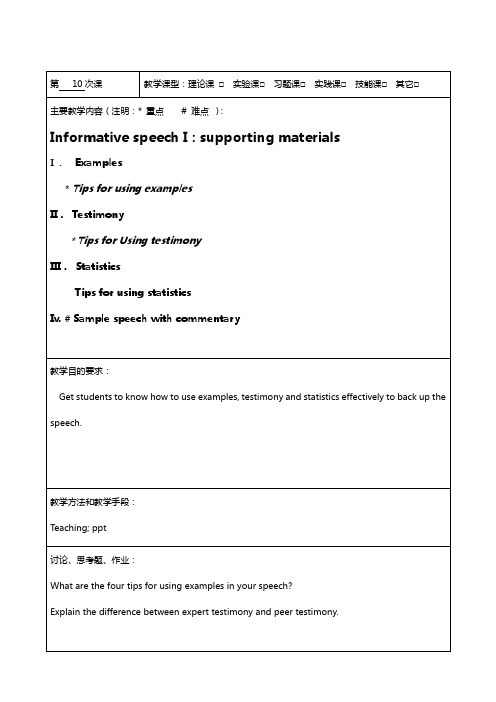
注:教案附后Lesson 9 Informative speech ISupporting your ideasHeather Kolpin decided to give her first classroom speech on the benefits of good nutrition. A dedicated fitness enthusiast, she had recently switched to a high-protein diet. Part of her speech ran like this:“For years we’ve been told that meat, eggs, and cheese are bad for us and that we should eat more carbohydrates like cereal, grains, pasta, and rice. But too many carbohydrates can unbalance the body and make you tired and overweight. Do you want more energy? Do you want to concentrate better and get higher grades? Do you want to enjoy real meals and still lose those unsightly pounds? If so, you should eat more protein. I’ve been on a high-protein diet for six months, and I’ve never felt better or done better in my classes!”After the speech, Heather’s classmates were interested but skeptical. As one remarked,“I knowhigh-protein diets are popular right now, but Heather is no expert on nutrition. Besides, there are lots of diets around, and they all claim to work wonders. Personally, I’d be more convinced if Heather gave some scientific evidence to back up her opinion.”Good speeches are not composed of hot air and generalizations. They need strong supporting materials to bolster the speaker’s point of view. In Heather’s case, although there is plenty of evidence on the need to balance protein and carbohydrate consumption, many nutritionists have warned about the dangers of overloading on protein. So Heather’s listeners were right to be skeptical. Heather made a mistake of generalizing from her own experience with nothing concrete to support her ideas.The problem with generalizations is that they do not answer the three questions listeners always mentally ask of a speaker: “What do you mean?”, “Why should I believe you?”“So what?”The skillful use of supporting materials often makes the difference between a poor speech and a good one. Using supporting materials is not a matter of tossing facts and figures into your speech. You must decide which ideas need to be supported given your audience, topic, and specific purposes. You must do research to find materials that will bring your ideas across clearly and creatively. And you must evaluate your supporting materials to make sure they really do back up your ideas.As you put your speeches together, you will need to make sure your supporting materials are accurate, relevant, and reliable. You will find yourself asking such questions as, “Are my examples representative?”,“Am I quoting reputable, qualified sources?”There are three kinds of supporting materials we use most often, they are: examples , testimony and statisticsI.ExamplesExamples:a specific case used to illustrate or to represent a group of people, ideas, conditions, experiences or the like.In the course of a speech you may use brief examples—specific instances referred to in passing —and sometimes you may want to give several brief examples in a row to create a stronger impression. Extended examples—often called illustrations, narratives, or anecdotes—are longer and more detailed.Examples are useful when you wish to make an abstract concept or idea concrete. For example, it is difficult for the audience to see exactly what you mean by such abstract concepts as persecution, denial of freedom, friendship, and love unless you provide specific examples of what you mean.Here is one example a student used in a speech about lead poison.‘When Denise Waddle and her family moved to a nice, middle-class section of Jersey City, New Jersey, they had dreams of healthy living, block parties, even a big backyard so their kid could make mud pies. In less than one year in their new home, their two-year-old son had been poisoned, and their newborn showed high levels of poisoning in his bloodstream. Unknowingly, the Waddle’s had been poisoned by their own backyard, for high levels of lead contaminated their water and their lives.”Examples may be real and factual on one hand or hypothetical and imagined on the other. The hypothetical and imagined ones are called hypothetical examples.Hypothetical example: an example that describes an imagery or fictitious situationHere is one student used a hypothetical example to illustrate the need for college students to protect themselves against crime:Y ou’re tired; you’re hungry. You’ve just spent a long day at College Library and you cannot wait to get back to your room. Glancing outside, you remember how quickly it becomes dark. You don’t think much of it, though, as you bundle up and head out into the gusty wind. Not until you spy the shadows on the sidewalk or hear the leaves rustling beside you do you wish you weren’t alone. You walk quickly, trying to stop your imagination from thinking of murderers and rapists. Only when you are safely inside your room do you relax and try to stop your heart from pounding out of your chest.Can you remember a time when you felt this way? I would be surprised if you never have. The FBI reported last year that there were three murders, approximately 430 aggravated assaults, 1400 burglaries, and 80 rapes here in Madison alone. And while these statistics are quite alarming, they don’t compare to the numbers of larger metropolitan areas.This hypothetical example is particularly effective. The speaker creates a realistic scenario, relates it directly to her listeners, and gets them involved in the speech. In addition, she uses figures from the FBI to show that the scenario could really happen to any of her classmates. Whenever you use a hypothetical example, it is a good idea to follow it with statistics or testimony to show that the example is not far-fetched.Tips for using examples1. Use examples to clarify your ideasExamples are an excellent way to clarify unfamiliar or complex ideas. This is why so many teachers use examples in the classroom. Examples put abstract ideas into concrete terms that listeners can easily understand.This principle works exceptionally well in speeches. Suppose you are talking about suspension bridges, you could give a technical descriptionThe suspension bridge has a roadway suspended by vertical cables attached to two or more main cables. The main cables are hung on two towers and have their ends anchored in concrete or bedrock.If your listeners were made up of people familiar with structural systems, they might be able to visualize what a suspension bridge looks like. But for listeners lacking this background, you might want to add a simple example:Two well-known suspension bridges are the Golden Bridge in San Francisco and the Brooklyn Bridge in New York.Because almost everyone has at least seen a picture of the Golden Bridge in San Francisco and the Brooklyn Bridge in New York, using them as examples clarifies your meaning quickly and effectively.2. Use examples to reinforce your ideasIn a speech entitled “Boxing: The most dangerous sport”, the speaker argued that professional boxing should be banned. To reinforce his point, he cited the example of Muhammad Ali, who suffers a severe case of Parkinson’s disease brought on by his years in the ring. The example is very effective. It put the medical facts about boxing and brain damage in vivid, human terms that everyone could understand.When you use examples, make sure it is representative. The example of Muhammad Ali is quite representative.3. Use examples to personalize your ideasPeople are interested in people. AS social psychologist Eliot Aronson said, “Most people aremore deeply influenced by one clear, vivid, personal example than by an abundance of statistical data. ”Whenever you talk, you can include examples that will add human interest to your speech. SEE WHICH OF THE FOLLOWING WOULD YOU BE MORE LIKELY TO RESPOND TO?There are many hungry families in our community who could benefit from food donations.Or:Let me tell you about Arturo. Arturo is four years old. He has big brown eyes and a mop of black hair and an empty belly. In all his four years on this earth, Arturo has never once enjoyed three square meals in a single day.You can also use personal examples: personal examples are an excellent way to clarify ideas and to build audience interest. To be most effective, they should be delivered sincerely and with strong eye contact.II.TestimonyTestimony ---quotations or paraphrases used to support a point..People tend to respect the opinions of people who have special knowledge or experience on the topic. By quoting or paraphrasing such people, you can give your ideas greater strength and impact. The two major kinds of testimony are expert testimony and peer testimony.Expert testimony:Testimony from people who are recognized experts in their fields. It is a good way to lend credibility to your speeches by citing the viewpoints of people who are experts. It shows that you are not just mouthing your own opinions, but your position is supported by people who are knowledgeable about the topic.Expert testimony is more important when a topic is controversial or when the audience is skeptical about a speakers’point of view.As Einstein has put it; as Li Siguang said…Peer Testimony---Testimony from ordinary people with firsthand experience or insight on a topic.Testimony not from famous people, but from ordinary citizens who have firsthand experience on the topic. This kind of testimony is especially valuable because it gives a more personal viewpoint on issues than can be gained from expert testimony. It conveys the feelings, the knowledge, the insight of people who speak with the voice of genuine experience.For example, if you were speaking about the barriers faced by people with physical disabilities, you would surely include testimony from doctors and other medical authorities. But in this case, the expert testimony would be limited because it cannot communicate what it really means to have a physical disability. To communicate that, you need statements from people who have physical disabilities---such as the following:Itzhak Perman, the world-renowned violinist whose legs are paralyzed, once said: “When you are in a wheelchair, people don’t talk to you. Perhaps they think it is contagious, or perhaps they think crippled legs mean a crippled mind. But whatever the reason, they treat you like a thing.”Paul Longmore, who lost the use of his legs as a child, notes that most people are uncomfortable in the presence of someone who is handicapped, “It’s only when they really go out of their way to get to know us,”he says, “that they realize we are just as bright, witty, and companionable as they are.”There is no way expert testimony can express theses ideas with same authenticity and emotional impact.Tips for Using testimony1.quote or paraphrase accurately: make sure you do not misquote someone; make sure you donot violate the meaning of statements you paraphrase; make sure you do not quote out of context(quoting a statement in such a way as to distort its meaning by removing the statement from the words and phrases surrounding it. ).e testimony from qualified sources. That is, use testimony from recognized experts orordinary citizens with special experience on the speech topic.e testimony from unbiased sources. Be sure to use testimony from credible, competent,objective authorities.4.Identify the people you quote or paraphrase. The usual way to identify your source is to namethe person and sketch her or his qualifications before presenting the testimony. For instance: John Silber, Chancellor of Boston University and Chairman of the Massachusetts Board of Education, remarks: “It is quite clear that remarkable competence in a language can be achieved in three years--- if theses years are the ages three, four, and five. There is no question that for the average child to become bilingual, the earlier the better. ”After this statement, there is no doubt about Silber’s qualifications or why the audience should respect his judgment on the subject of education.III.StatisticsWe live in an age of statistics. Day in and day out we are bombarded with numbers. When used properly, statistics is an effective way to clarify and support ideas.Like brief examples, statistics are often cited in passing to clarify or strengthen a speaker’s point. The following examples show how three students used statistics in their speeches:To show the dangers posed by running red lights: “According to the U.S. Department ofTransportation, 200,000 people are injured and more than 800 are killed every year in the U.S. due to motorists who run red lights.”To illustrate the growing popularity of organic foods: “Consumers Union reports that sales of organic crops now exceed $9 billion a year and are increasing at the rate of 20 percent annually.”To document the problem of identity theft: “As stated by Newsweek magazine, identity theft has become the leading source of consumer fraud in the U.S., with an estimated 500,000 to 700,000 victims each year.”When using statistics, ask yourself the following two question:Are the statistics representative?Are the statistics from a reliable source?Tips for using statisticsUse statistics to quantity your ideasThe main value of statistics is to give your ideas numerical precision. This can be especially important when you are trying to document the existence of a problem. Examples can bring the problem alive and dramatize it in personal terms. But your listeners may still wonder how many people the problem actually affects. In such a situation, you should turn to statistics. Research has shown that the impact of examples is greatly enhanced when they are combined with statistics that show the examples to be typical.Suppose you are talking about the need for tougher driver’s license requirements for elderly drivers. Part of your speech deals with the growing number of auto accidents caused by drivers aged 70 and older. You give an example, you personalize it, you provide many details, as follows:Marie Wyman’s 87th birthday celebration at the Lobster Trap and Steakhouse in Winslow, Maine, ended with a bang. As Wyman backed out of her parking spot, she lost control of her Buick and plowed right through the restaurant’s crowded dining room. T ables and chairs scattered as terrified diners scrambled for cover. Twenty-seven people were injured, and police say it was a miracle that no one was killed.Then the speaker used figures to quantity the problem:According to the National Highway Traffic Safety Administration, almost 5,000 drivers age 70 or older were killed last year, a 33 percent increase over the past 10 years. In few than 20 years, there will be more than 30 million drivers over age 70 in the United States, and highway safety experts warn that the number of people killed in crashes involving elderly motorists is likely to exceed the drunk-driving death toll.Use statistics sparinglyNothing puts an audience to sleep faster than a speech scattered with numbers from beginning to end. Insert statistics only when they are needed, and then make sure that they are easy to grasp. Identify the source of your statisticsAs we have seen, figures are easy to manipulate. This is why careful listeners keep an ear out for the sources of a speaker’s statistics. Tell your listeners where your statistics is from, and it is reliable.Explain your statisticsStatistics don’t speak for themselves, they need to be interpreted and related to your listeners.A speech made by US Secretary of State Collins Powell on the international AIDS crisisMany speakers have noted the dreadful toll that AIDS is taking….But let me try to make it more relevant.This hall holds about 2,000 people. By the time the three hours of this session elapse, 2,000people around the world---just about the same number who are here---will be newly infected with HIV/AIDS. That’s one for every person in this room. In some countries the infection rate is so high that one in three of us---the delegate to your right, the delegate to your left, or you, yourself---would be HIV positive.Explaining what statistics mean is particularly important when you deal with large numbers, since they are hard to visualize. Here is an example to explain the $6.5 trillion U.S. national debt.How much money is a trillion dollars? Think of it this way. If you had $1million and spent it at the rate of $1,000 a day, you would run out of money in less than three years. If you had $1 billion and spent it at the rate of $1,000 a day, you would not run out of money for almost 3,000 years. And if you had $ 1 trillion and spent it at the rate of $1,000 a day, you wouldn’t run out of money for nearly 3 million years!Round off complicated statisticsSometimes you do not have to give the exact number; they are too complicated to be really understood by listeners. Unless there is an important reason to give exact numbers, you should round off most statistics.For instance, Mount Kilimanjaro is 19,341, you should say , it is 19,300.The moon is 238,855 miles from earth, you should say: it is 239,000 miles from earth.Use visual aids to clarify statistical trendsVisual aids can save you a lot of time, as well as make your numbers easier to understand.Sample speech with commentaryThe following speech illustrates how to wok supporting materials into a presentation. as you readstudy how the speaker uses a variety of examples, statistics, and quotations to make her ideas clear, credible, and convincing.Suffer the childrenMatthew Garvey was just 13 years old when he was hired by Quality Car Wash in Laurel, Maryland, to towel-dry cars as they came off the line. Not long after he began working, Matthew lost his right leg when it got caught in an industrial machine used to suck the moisture out of the towels. After investigating, the U.S. Department of Labor fined the car wash for illegally hiring a minor and for operating a machine with a broken safety lid.The speaker begin with an extended example to gain attention and interest The example is specific and detailed .We are told Matthew Garvey’s name and age, where he lived, the kind of work he did ,and how he was injured. These are the kinds of details that bring examples to life and help get listeners involved in a speech.This in just one of the more tragic examples of what Jeffrey Newman of the National Child Labor Committee calls the “crisis”of child-labor law abuses in the United States. In researching this speech, I discovered that employers from New York to California are breaking the law by hiring children from age 7 to 17 who often put in long, hard hours in dangerous conditions Today I would like to show you the extent of the problem and how it jeopardizes the education and safety of millions of young people.The speaker moves into testimony suggesting that the opening story is representative of a major problem in the U.S. When you use an extended example, it is usually a good idea to precede or follow the example with statistics or testimony showing that the example is not unusual or exceptional.To understand the problem of child-labor law violations we need to begin by looking at the provisions of the law. As explained on the U.S. Department of Labor website, the Fair Labor Standards Act sets a minimum working age of 14.It limits 14-year-old and 15-year-old to three hours of work on school days, prohibits them from working after 7 at night, and allows them a total of 18 work hours per week during the school year. The law also restricts employment of children under 18 in dangerous jobs such as construction, meat-cutting, and mining.In her first main point the speaker explores the problem of child-labor law violations in the United States. She begins by summarizing the provisions of the law. Notice how she identifies the website where she acquired the information.Passed in 1938 and amended several times since, the Fair Labor Standards Act was designed to prevent the exploitation of child labor that took place during the 19th century. Yet today violations of the law are shockingly widespread. According to the Associated Press, 148,000 minors in the U.S. are employed illegally in nonagricultural jobs during an average week, working too many hours or in hazardous conditions. In addition, the National Child Labor Committee reports that more than 110,000 children work illegally on U.S. farms.Statistics in this and the next paragraph back up the speaker’s point that violations of child-labor laws are widespread in the U.S. Rather than giving the exact number of violations, she round them off, making them easier to grasp and recall.Some of the most serious violations occur in garment industry factor is known as sweatshops that hire immigrant children at rates well below minimum wage. The Associated Press estimates that as many as 2,600 minors are employed illegally in New York City sweatshops. Thomas Cubiak, head of the city’s garment district task force, says “most of the children in these factories are below 18, some as young as 8.”Like Faviola Flores, a 15-year-old Mexican girl in a Manhattan sweatshop, they toil long days in unsafe conditions for as little as $3.50 an hour. “I don’t like working here,”Flores says, ”but I have no choice.”The speaker uses a combination of statistics and testimony to support her point about child-labor abuses in the garment industry. The statement form Thomas Gubiak is an example of expert testimony; the closing quotation from Faviola Flores in an instance of peer testimony.Although the exploitation of child labor has been a problem in the garment trade since the 1800s, it can be found in almost every industry that employs minors. In January 2000, Wagner’s Meats of New Orleans was fined nearly $150,000 for illegally employing 27 minors in dangerous jobs and for exceeding federal hour limits. In February 2001, Thornton Roofing was fined $34,000 for child-labor violations in connection with the death of a teenage worker in Montgomery, Alabama. In March 2002, the Six Flags amusement parks paid $85,000 in penalties for violating federal child-labor laws.A series of brief examples supports the speaker’s claim about the pervasiveness of child-labor law violations. Because the examples deal with companies throughout the U.S. and in different lines of business, they provide strong evidence to reinforce the speaker’s point that violations of the law are widespread.Like other business caught breaking child-labor laws, Wanger’s and Six Flags tried to downplay the seriousness of their offenses. But the growing epidemic of child-labor law violations threatens both the education and the physical safety of young workers.The speaker begins her second main point—that violations of child-labor laws have serious consequences for the education and physical safety of young workers.The educational consequences are most damaging to illegal underage employees who work instead of attending school. As Hugh McDaid of New York City’s garment task force says, illegal underage workers “sacrifice their education and literally commit themselves to a life of working in a sweatshop. They have on future.”But even for children who do attend school, too many hours at work can harm their education. In their book When Teenager Work, psychology professors Ellen Greenberger and Laurence Steinberg note that intensive levels of work among youth tend to produce higher truancy and lower grades. According to Greenberger and Steinberg, one study after another has found that working more than a very few hours a week has a negative impact on teenagers’academic performance.The quotation from Huge McDaid is a good instance of expert testimony. This quotation, like others in the speech , is short and forceful. There is no reason to use a direct quotation unless it makes the point more clearly and forcefully than you can in your own words.Here the speaker paraphrases rather than quoting verbatim. Notice that she gives the name of the book she is paraphrasing from and identifies its authors. Speakers have an ethical obligation to indicate the sources of paraphrases, as well as of quotations.Not only do child workers harm their education, but they often endanger their physical safety as well . Recall the story I told in my introduction about Matthew Garvey, the 13-year-old who lost his leg while working at a car wash. Even more tragic is the case of Michael Hurcone, a 17-year-old Pennsylvania high-school student. While employed at a supermarket, he was working with a bailer —a machine that crushes and bins cardboard boxes and is supposed to be off-limits to minors. Noticing that some material was stuck in the bailer, Michael tried to free up the jam when he got caught in the machine. It crushed his body for 30 minutes before he suffocated.The examples in this paragraph show specific cases in which teenagers were injured or killed by the violation of child-labor laws. The extended example about Michael Hurcone is especially effective. Filled with specific details that make it interesting and credible, it puts the speaker’s point in human terms with which the audience can identify.Nor are these isolated examples. USA Today reported on July 12, 2002, that 230,000 teenagers are injured at work each year. According to former U.S. Labor Secretary Alexis Herman, nearly 70 minors are killed on the job annually—most in accidents involving infractions of child-labor laws.In this paragraph he speaker presents testimony and statistic to prove that the examples in the previous paragraph are not atypical. As in other parts of the speech, she is quite specific in identifying the sources of her evidence.In the light of all this evidence, there can be no doubt that the violation of child-labor laws is widespread problem with serious consequences. The issue is well summarized by former U.S. Senator Howard Metzenbaum of Ohio, who stated after congressional hearings on the subject, “I shudder to think that children the same age as my own grandchildren are being robbed of an education, their limbs, and indeed, their lives through illegal child labor.”The speaker begins her conclusion by summarizing the two main points she had made in the body of the speech. She then ends with a dramatic quotation,. As we shall see in previous chapter,, this is an effective way to pull a speech together and to reinforce its central idea.SummaryGood speeches are not composed of hot air and unfounded assertions. They need strong supporting materials to bolster the speaker’s point of view. In fact, the skillful use of supporting materials often makes the difference between a good speech and a poor one. The three basic types of supporting materials are examples, statistics, and testimony.In the course of a speech you may use brief examples—specific instances referred to in passing —and sometimes you may want to give several brief examples in a row to create a stronger impression. Extended examples—often called illustrations, narratives, or anecdotes—are longerand more detailed. Hypothetical examples describe imaginary situations and can be quite effective for relating ideas to the audience. All three kinds of examples help clarify ideas, reinforce ideas, or personalize ideas. To be most effective, though, they should be vivid and richly textured.Testimony is especially helpful for student speakers because students are seldom recognized as experts on their topics. Citing the views of people who are experts is a good way to make your ideas more credible. When you include testimony in a speech, you can either quote or paraphrase his or her words. As with statistics, there are guidelines for using testimony. Bu sure to quote or paraphrase accurately and to cite qualified, unbiased sources. If the source is not generally known to your audience, be certain to establish his or her credentials.Statistics can be extremely helpful in conveying your message as long as you can use them sparingly and explain them so that they are meaningful to your audience. Above you should understand your statistics and use them fairly. Numbers can easily be manipulated and distorted. Make sure your figures are representative and reliable.。
英语演讲口才教案模板范文
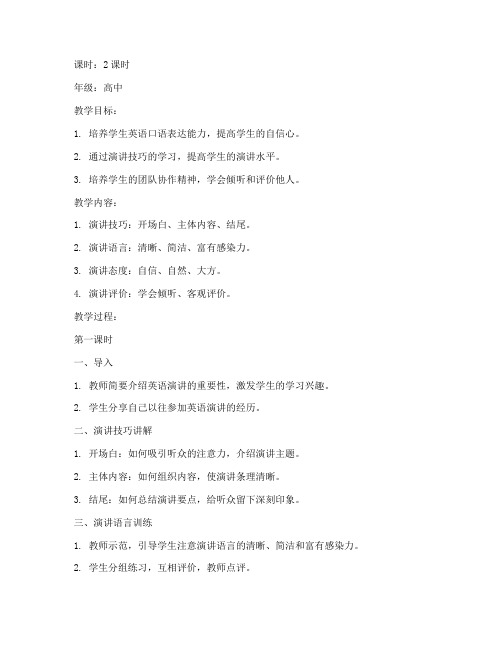
课时:2课时年级:高中教学目标:1. 培养学生英语口语表达能力,提高学生的自信心。
2. 通过演讲技巧的学习,提高学生的演讲水平。
3. 培养学生的团队协作精神,学会倾听和评价他人。
教学内容:1. 演讲技巧:开场白、主体内容、结尾。
2. 演讲语言:清晰、简洁、富有感染力。
3. 演讲态度:自信、自然、大方。
4. 演讲评价:学会倾听、客观评价。
教学过程:第一课时一、导入1. 教师简要介绍英语演讲的重要性,激发学生的学习兴趣。
2. 学生分享自己以往参加英语演讲的经历。
二、演讲技巧讲解1. 开场白:如何吸引听众的注意力,介绍演讲主题。
2. 主体内容:如何组织内容,使演讲条理清晰。
3. 结尾:如何总结演讲要点,给听众留下深刻印象。
三、演讲语言训练1. 教师示范,引导学生注意演讲语言的清晰、简洁和富有感染力。
2. 学生分组练习,互相评价,教师点评。
四、演讲态度训练1. 教师示范自信、自然、大方的演讲态度。
2. 学生模仿,互相评价,教师点评。
五、课堂小结1. 教师总结本节课的学习内容,强调演讲技巧、语言和态度的重要性。
2. 学生分享学习心得。
第二课时一、复习上节课内容1. 教师提问,检查学生对演讲技巧、语言和态度的理解。
2. 学生回答,教师点评。
二、演讲实践1. 学生分组,每组准备一篇演讲稿。
2. 每组派代表进行演讲,其他组员倾听并评价。
3. 教师点评,提出改进意见。
三、团队协作训练1. 学生分组,每组进行一个英语演讲比赛。
2. 比赛结束后,各组成员分享经验,互相学习。
3. 教师点评,总结团队协作的重要性。
四、课堂小结1. 教师总结本节课的学习内容,强调团队协作和演讲技巧的重要性。
2. 学生分享学习心得。
教学评价:1. 课堂参与度:评价学生在课堂上的发言、练习和互动情况。
2. 演讲水平:评价学生在演讲实践中的表现,包括语言、技巧和态度。
3. 团队协作:评价学生在团队协作中的表现,包括沟通、分工和协作。
教学反思:1. 教师反思本节课的教学效果,针对学生的不足,调整教学策略。
大学英语获奖教案

教案名称:英语演讲比赛课程背景:本课程旨在提高学生的英语口语表达能力,激发学生学习英语的兴趣,培养学生跨文化交际的能力。
通过组织英语演讲比赛,让学生在真实的语言环境中运用所学知识,提高他们的语言组织能力、公众演讲能力和团队合作能力。
教学目标:1. 提高学生的英语口语表达能力,使他们能够流利地用英语表达自己的观点。
2. 培养学生的跨文化交际能力,使他们能够理解和尊重不同文化背景下的表达方式。
3. 培养学生的团队合作能力,使他们能够在团队合作中发挥自己的优势,共同完成任务。
4. 提高学生对英语演讲技巧的掌握,使他们能够在演讲中运用恰当的语音、语调和肢体语言。
教学内容:1. 英语演讲的基本原则和技巧2. 演讲稿的撰写方法和注意事项3. 演讲过程中的语言组织、语音语调和肢体语言运用4. 跨文化交际中的语言表达和沟通技巧教学过程:1. 课前准备:教师为学生提供演讲主题,要求学生提前准备演讲稿。
学生可以通过查阅资料、请教同学和老师等方式来完成演讲稿的撰写。
2. 课堂讲解:教师针对英语演讲的基本原则和技巧进行讲解,包括语言组织、语音语调和肢体语言的运用。
同时,教师还可以分享一些成功的演讲案例,让学生从中学习和借鉴。
3. 小组讨论:学生分成小组,互相交流演讲稿的撰写心得和演讲技巧。
每个小组选出一个代表进行演讲,其他组员为其提供反馈和建议。
4. 课堂练习:学生在课堂上进行演讲练习,教师对其进行评价和指导。
教师可以针对学生的不足之处进行针对性训练,帮助他们提高演讲能力。
5. 演讲比赛:组织全班的英语演讲比赛,让学生在真实的比赛环境中展示自己的英语口语表达能力。
比赛可以设置不同的奖项,以鼓励学生的积极参与和努力。
6. 总结与反思:在比赛结束后,教师和学生一起总结比赛过程中的优点和不足,共同探讨如何进一步提高英语口语表达能力。
教学评价:1. 学生演讲稿的撰写质量,包括内容完整性、逻辑性和语言准确性。
2. 学生演讲过程中的语言组织、语音语调和肢体语言运用。
(完整版)《英语演讲》教案

(完整版)《英语演讲》教案教案(进度、⼤纲、讲义、课件)授课⼈:Tel:E-mail:进度请任课教师第⼀堂课向学⽣详细解说课程⼤纲和学习规则,包括课程的结构、主要与次要的内容、教学⽬标、进度安排、教与学的⽅法、作业要求、答疑时间与联系⽅式、成绩考核依据、旷课处理、相关材料及阅读技巧、必要的阅读书⽬、实践及练习时间等。
进度安排《英语演讲》⼤纲《英语演讲》教学⼤纲前⾔(⼀) 本门课程的性质和教学⽬的(⼆) 本门课程的教学要求(三) 推荐使⽤的教材和课外阅读书⽬1. 推荐使⽤的教材2. 课外阅读书⽬(四) 本门课程教学的课时分配本门课程的教学计划课时为36课时(2学分), 建议教学课时按以下⽅案分配:课程教学内容与要求Unit One Course Overview; Basic Principles of Speech Communication教学⽬的和要求内容讲解Unit Two Analyzing the Audience教学⽬的和要求本单元讲授演讲前的准备⼯作之⼀:了解听众,根据听众的特征,调整演讲内容。
通过教师的讲授与⽰范,调动学⽣的积极性,参与演讲实践。
内容讲解《英语演讲》讲义IntroductionWhat is public speaking?Public speaking, as its name implies, is a way of making your ideas public – of sharing them with other people and of influencing other people.A Brief Introduction to public speakingI. How to Prepare a SpeechStating Your Objectives:◇inform◇train◇persuade◇sellAnalyzing Your AudienceWhat to learn about the audience?Their opinions and levels of prior knowledge of your subject ; their likely bias, both personal and professional how do you learn it?Ask the person who has invited you to speak. Find out what the occasion is and if there is a program theme. Choosing a Speech Topic and the Speech ThemeSix Criteria1. The topic should be interesting to you.2. It should be interesting to your audience or at least be capable of beingmade interesting to them.3. It should be appropriate to the situation.4. It should be appropriate to the time available.5. It should be manageable.6. It should be worthwhile. Don't waste yo ur audience’s time.Gathering and Selecting Appropriate Materialsconvincing materialsseven major types of materials: descriptions and explanations, statistics,examples, testimony, comparison and contrast, repetition and restatement, and visuals. guidelines Outlining Your Speechguidelines:1. Write and label your specific purpose at the top of your outline.2. Indicate main ideas, points, sub-points, and supporting materialsproperly.3. Use at least two subdivisions, if any, for each point.Using subdivisions helps you give attention to all the points you want to say.4. Label the introduction, main body and conclusion.II. How to Write a Great SpeechOrganizing the Body of the SpeechA.The IntroductionA. It should introduce the topic. providing background information, definitionsexplanations, etc.B. Generally it should contain the thesis statement.C. It should be interesting enough to make the listener want to continue listening.Anecdotes, shocking statistics, quotes, and rhetorical questionsD. It should indicate how your topic will be developed.E. tell your listeners WHY they should listen to you; such as how they will benefit.F. include the method of organization that you will follow. This helps the listenerprepare for what you are going to say and help them organize the information.An effective introductionCreates a favorable first impression with the audienceBoosts a speaker’s self-confidenceGaining attentionrelate the topic to the audienceState the importance of the topicStartle the audienceArouse the curiosity of the audienceQuestion the audienceBegin with quotationTell a storyUsing visual aids…Reveal the topicClearly states the speech topicEstablish the credibility and goodwill of the speakerPreview the bodyTells audience what to listen for in the restProvide a smooth lead-inPresent special informationB.Main Bodya. Each main point discusses one aspect of the thesis.b. The main points should be linked with clear transitions so as to give the body coherence and unity.C. ConclusionA conclusion can restate the thesis.A conclusion can restate the main points.A conclusion can call for some sort of action (particularly in a persuasive piece)A conclusion can highlight areas for further research.A conclusion can suggest results or consequences.A conclusion can remind the audience of the importance of the information presented.The speaker can thank the audience for their attention.A conclusion should NEVER bring up a new topic.A speaker should NEVER apologize for their information. The last thing you want to happen is for the audience to question your credibility.2 functions of conclusionSignal the end of the speechReinforce the audience’s understanding of the speechUsing Speech LanguageA. Using Language AccuratelyB. Use Language ClearlyC. Use language VividlyIII. How to Deliver a Great SpeechPhysical Delivery1. postureA public speaker should look comfortable, confident and prepared to speak. Inposture, the two extremes to avoid are rigidity and sloppiness.2. facial expressionsYour facial expression must match what you are saying.3. movementa. Never turn your back on the audience while you are speaking.b. If you move about on the stage, make your movements purposeful.c. Be aware of all potential obstacles on the stage.4. gestures5. Eye contactLet your gaze move over each member of the audiencedon’t choose one person and look fixedly at him or her.avoid the temptation to look over the heads of your audience or to hold your notes in front of your face.6. AppearanceThe way you dress and present yourselfDress appropriately to the audienceVocal DeliveryV ocal delivery refers to the use of your voice to convey your message.1. rateRate is the speednot too slowly or too quickly. Varying your rate can be critical.2. pausetemporary stopspause before and after a major point. You can use pauses to illustrate that you are changing from one point to another. Youcan use pauses for emphasis3. volumeV olume refers to how loud one speaksSpeak too soft Speak too loudchanging the volume at certain points emphasize important ideas.Raising your voice lowering your voice4. pitchPitch refers to the high or low quality of your voice.V olume is measured in terms of loudness.The pitch of your voice in public speaking refers to the “excitement” or “enthusiasm” level in your voice.pitch can be raised and lowered for emphasis.vary your pitch.5. Pronunciation6. articulation : not slur, speak clearlyIV. How to Analyze and Evaluate Speechthree “M”s: matter, manner and method.Speaking to PersuadeI. Persuasion: a Psychological processA. Persuasion is the most complex and the most challenging.(controversial topics, involving values and beliefs; listeners’ own ideas)B. Listeners: mental give-and-take(listeners: assessment on speakers)II. The Target AudienceThe part of the whole audience a speaker most wants to reach with his message. Agree and disagree audience Adapt the speech to the values and concerns of the TADo not exclude other listenersIII. Monroe’s Motivated SequenceMonroe's motivated sequence is a technique for organizing persuasive speeches that inspire people to take action. Alan H. Monroe (Purdue University) 1930swhat creates makes a motivational speech actually motivating.a 5-step method for organizing motivational speeches.1.AttentionGet the attention of your audience using a detailed story, shocking example, dramatic statistic, quotations, etc.E.g. Hey! Listen to me, I have a PROBLEM!2.NeedShow that the problem about which you are speaking exists, that it is significant, and that it won't go away by itself. Use statistics, examples, etc.Convince your audience that there is a need for action to be taken.E.g. Let me EXPLAIN the problem.3.Satisfy.You present your plan and show how it will work. Be sure to offer enough details about the plan.E.g. But, I have a SOLUTION!4.VisualizationTell the audience what will happen if the solution is implemented or does not take place. Be visual and detailed.E.g. If we IMPLEMENT my solution, this is what will happen.5.Action.Tell the audience what action they can take personally to solve the problem.Say exactly what you want the audience to do and how to do it.E.g. You can help me in this specific way. Are YOU willing to help me?Advantage of MMSIt emphasizes what the audience can do. Monroe's motivated sequence emphasizes the action the audience can take. Sample Speech:The Ultimate GiftIV. Persuasive Speeches on Questions of FactA. seek to persuade audience to accept the speaker’s view of the facts on a particular issue.E.g. Will the economy be better or worse next year?B. different from an informative speechIS: give information as impartially as possible ≠ argue for a point of viewPS: persuade the audience to accept the speaker’s view about the informatione.g. In a trial lawyer jury guilt / innocent defendantV. Persuasive Speeches on Questions of ValueA. Judgments based on a person’s beliefs about what’s right or wrongB. 2 steps:1. define the standards for value judgments2. judge the subject of the speech against the standards.VI. Persuasive Speeches on Questions of PolicyA. deal with specific courses of action: involve questions of fact and value; go beyond thatB. 2 types:1. gain passive agreement that a policy is desirable, necessary & practical2. motivate the audience to take immediate actionC. 3 basic issues – need, plan & practicality1. need: (no) need for a change2. a specific plan: solve the need3. practicality: Plan: workable, solve the need without creating newproblemsVII. Methods of PersuasionA.Building credibility– 1. Credibility affected by: competence & charactercompetence: speaker’s intelligence, expertise & knowledge of the subjectcharacter: speaker’s sincerity, trustworthiness– 2. 3 types of credibility: initial credibility; derived credibility;terminal ~– 3. 3 strategies to ↑credibility:a. explaining their competenceb. establishing common ground with the audiencec. delivering speeches fluently, expressively and with conviction/doc/2d066e28ba4ae45c3b3567ec102de2bd9605de08.html ing Evidence– 1. examples, statistics, testimony– 2. 4 tips to use evidence effectively: use specific evidence; novel ~; use ~ from credible sources; make clear the point of the ~C.Reasoning–Reasoning: the process of drawing a conclusion based on evidence–use reasoning from specific instances–use reasoning from principle–use analogical reasoning, ×casual reasoningD.Emotions Appeals– 1. Emotions Appeals (motivational appeals): make listeners feel sad, happy, angry, fearful, etc.– 2. 3 ways: with emotionally charged language; with vivid examples;speak with sincerity and convictionPresentation on Special occasionsPresentation in Welcome Ceremonies, Conferences, or Parties Presentation in FarewellAward presentationAcceptance Presentation。
大学英语口语演讲教案

大学英语口语演讲教案1. 引言在大学英语教育中,培养学生的口头表达能力是非常重要的一环。
英语口语演讲作为提高学生口语能力和自信心的有效手段之一,受到越来越多大学课程的关注。
本文将为您呈现一份详细的大学英语口语演讲教案,旨在帮助指导者设计并组织有效的口语演讲课程。
2. 教案目标•培养学生在公众场合中流利、自信地表达自己观点和想法的能力。
•提高学生在口头表达方面的基本技能,如发音、语调、用词等。
•开拓学生思维,增强他们对不同话题和观点的理解与分析能力。
3. 教案内容第一阶段:准备阶段•学习主题选择与组织结构:引导学生选择适合他们兴趣和知识背景的主题,并学习如何组织清晰、连贯的演讲结构。
•材料收集与整理:教授学生如何从各种来源搜集相关信息,并进行整理和归纳。
•写作与修改:讲解写作技巧,引导学生撰写演讲稿并进行反复修改与完善。
第二阶段:口头表达训练•发音与语调练习:通过模仿和朗读自然拟真的英语口音,并模拟不同场景下的语调,帮助学生提高发音和节奏感。
•表达技巧培养:教授学生如何运用恰当的表达手法,如使用幽默、问答等方式来吸引听众的注意并增加演讲的吸引力。
•观摩与评估:组织学生相互观摩演讲,并提供具体建议和评估意见以帮助他们改进。
第三阶段:实践与展示•分组演讲活动:组织学生按照一定顺序分组进行演讲,以便他们能够互相交流和分享经验。
•公开演讲展示:安排公开的演讲展示活动,在全班或更大范围内集中展示学生的口语表达成果。
•反馈与总结:收集听众的反馈意见,并对整个教案进行总结和评估。
4. 教学方法•互动式教学:通过引导学生讨论、小组活动、角色扮演等方式,积极参与学生的口头表达培养过程。
•实践导向:提供大量实际练习机会,帮助学生从实践中提升口语表达技巧。
•鼓励与奖励机制:通过奖励和鼓励,激发学生的积极性和自信心。
5. 教案评估•学生表现评估:根据学生在准备阶段的资料收集、写作与修改情况以及口头表达训练阶段的发音、语调等方面进行评估。
幼儿园英语:小小英语演讲家教案

幼儿园英语:小小英语演讲家教案教学主题:小小英语演讲家教学目标:1. 学生了解演讲的概念和重要性。
2. 学生能够表达自己的意见和看法。
3. 学生能够用正确的语音、语调和动作进行演讲。
4. 学生能够在一定范围内选择和整理演讲材料。
教学内容:1. 了解演讲的概念和重要性。
2. 观看演讲视频,了解正确的演讲姿势和语调。
3. 练习基本英语口语,提高语音和表达能力。
4. 选取感兴趣的话题,进行演讲练习。
教学过程:Step 1. 导入新课教师通过图片和视频介绍演讲的概念和重要性,并激发学生对演讲的兴趣。
Step 2. 观察演讲视频提供优秀的英文演讲视频,并让学生观看视频。
教师要求学生仔细观察演讲者的语音、语调以及姿势动作,并了解演讲的主题和内容。
Step 3. 练习英文口语为了提高学生的语音和表达能力,教师将学生分为小组,让每组选出一位代表用英文介绍自己,并组织其他学生进行评论和点评。
通过这种方式,学生可以更好地锻炼自己的英语口语表达能力,并且互相交流,一起进步。
Step 4. 选择演讲主题教师要求学生在课前选出自己感兴趣的主题,并整理相关材料。
比如:我喜欢的动物,我的假期生活,我最喜欢的科学事实等,每个学生可以在五分钟内进行演讲。
Step 5. 执行演讲教师在课堂上进行小型英文演讲比赛,允许每个学生进行演讲,并对他们的讲演给予必要的点评和认可。
教师还可以邀请其他教师和家长来到现场观看和评价演讲表现。
Step 6. 总结在比赛结束后,教师可以和学生们一起回顾整个演讲过程,探讨发言技巧和语音发音等问题。
并且表彰获胜的同学,并适当地给予批评和鼓励。
教学评价:1. 学生能够了解演讲的概念和重要性。
2. 学生能够使用基本英语表达自己的意见和看法。
3. 学生能够用正确的语音、语调和姿势进行演讲。
4. 学生能够选择和整理有关个人经验的演讲材料。
扩展:1. 教师可以让学生互相交流和分享自己的演讲材料,以增强学生之间的交流和合作精神。
英语演讲与辩论教案
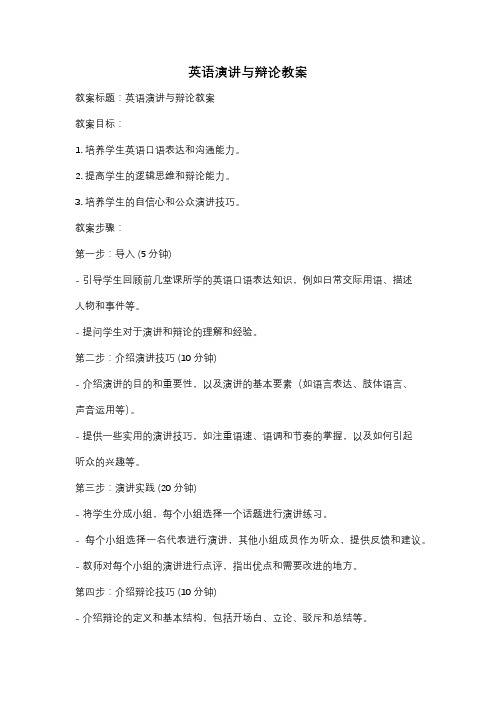
英语演讲与辩论教案教案标题:英语演讲与辩论教案教案目标:1. 培养学生英语口语表达和沟通能力。
2. 提高学生的逻辑思维和辩论能力。
3. 培养学生的自信心和公众演讲技巧。
教案步骤:第一步:导入 (5分钟)- 引导学生回顾前几堂课所学的英语口语表达知识,例如日常交际用语、描述人物和事件等。
- 提问学生对于演讲和辩论的理解和经验。
第二步:介绍演讲技巧 (10分钟)- 介绍演讲的目的和重要性,以及演讲的基本要素(如语言表达、肢体语言、声音运用等)。
- 提供一些实用的演讲技巧,如注重语速、语调和节奏的掌握,以及如何引起听众的兴趣等。
第三步:演讲实践 (20分钟)- 将学生分成小组,每个小组选择一个话题进行演讲练习。
- 每个小组选择一名代表进行演讲,其他小组成员作为听众,提供反馈和建议。
- 教师对每个小组的演讲进行点评,指出优点和需要改进的地方。
第四步:介绍辩论技巧 (10分钟)- 介绍辩论的定义和基本结构,包括开场白、立论、驳斥和总结等。
- 解释如何构建有力的论点,如何有效地驳斥对方观点,以及如何进行合理的总结。
第五步:辩论实践 (20分钟)- 将学生分成两个辩论小组,每个小组选择一个争议性话题进行辩论。
- 每个小组分为正方和反方,进行辩论实践。
- 教师担任裁判,评判每个小组的辩论表现,并给予积极的反馈和建议。
第六步:总结和评估 (10分钟)- 学生回顾整个教学过程,总结所学的演讲和辩论技巧。
- 教师进行课堂评估,了解学生的学习效果和掌握程度。
- 鼓励学生继续进行演讲和辩论的实践,提供更多的机会和资源。
教案扩展:- 鼓励学生参加学校或社区的演讲和辩论比赛,提供指导和支持。
- 提供更多的演讲和辩论素材,如名人演讲、时事热点等,让学生进行更深入的讨论和辩论。
- 组织学生进行小组辩论赛,培养合作和竞争意识。
教案评估:- 学生的演讲和辩论表现。
- 学生对于演讲和辩论技巧的掌握程度。
- 学生的合作和沟通能力的提高程度。
英语演讲选修课教案informativespeech I

英语演讲选修课教案Informative Speech I第一章:课程介绍1.1 课程目标让学生掌握informative speech 的基本概念和技巧提高学生的英语口语表达能力和公共演讲能力培养学生的自信心和领导力1.2 课程内容介绍informative speech 的定义和特点介绍informative speech 的结构和组织方式介绍如何选择和研究informative speech 的主题介绍如何进行资料搜集和资料整理1.3 教学方法讲授与实践相结合小组讨论和同伴评价角色扮演和模拟演讲第二章:Informative Speech 的定义和特点2.1 informative speech 的定义解释informative speech 的概念和意义强调informative speech 的目的和作用2.2 informative speech 的特点介绍informative speech 的主要特点,如信息性、逻辑性和条理性等分析informative speech 与其他类型的演讲(如persuasive speech 和impromptu speech)的区别2.3 案例分析第三章:Informative Speech 的结构和组织方式3.1 结构概述介绍informative speech 的基本结构,包括引言、主体和结尾等部分强调每个部分的功能和重要性3.2 组织方式介绍informative speech 的常见组织方式,如时间顺序、空间顺序和分类等分析不同组织方式的优缺点和适用场景3.3 案例分析第四章:选择和研究informative speech 的主题4.1 主题选择的重要性强调选择合适主题的重要性,如兴趣、熟悉度和信息性等提供一些选题的技巧和建议4.2 研究主题的方法介绍如何进行主题研究和资料搜集,如利用图书馆、网络资源和采访等强调资料整理和筛选的重要性4.3 案例分析第五章:进行资料搜集和资料整理5.1 资料搜集的方法介绍如何利用图书馆、网络资源和采访等进行资料搜集强调资料的可靠性和准确性5.2 资料整理的技巧介绍如何整理和筛选搜集到的资料,如制作笔记、制定提纲等强调资料整理的重要性5.3 案例分析强调引言部分的重要性和影响力介绍如何组织主体内容,包括选择合适的细节和例证来支持主题强调主体部分的逻辑性和连贯性强调结尾部分的重要性第七章:演示技巧与视觉辅助7.1 演示技巧的运用介绍如何在演讲中运用肢体语言、面部表情和声音变化等演示技巧强调演示技巧对于增强演讲效果的重要性7.2 视觉辅助工具的使用介绍如何使用幻灯片、图表和其他视觉辅助工具来辅助演讲强调视觉辅助工具的吸引力和信息传递能力第八章:演讲练习与反馈8.1 个人演讲练习安排学生进行个人演讲练习,鼓励他们运用所学的技巧和知识提供反馈和指导,帮助学生改进演讲表现8.2 同伴评价和小组讨论组织学生进行同伴评价和小组讨论,让他们互相交流和分享经验强调同伴评价的重要性和相互学习的机会第九章:演讲展示与评价9.1 演讲展示的准备强调演讲展示的重要性和准备工作的必要性9.2 演讲展示的评价制定评价标准和评分准则,对学生的演讲展示进行评价强调评价的公正性和客观性,以及对学生的鼓励和指导10.1 课程内容的回顾强调课程的重要性和对个人发展的贡献10.2 提升演讲技巧的途径介绍一些提升演讲技巧的额外资源和活动,如参加演讲俱乐部、观看演讲视频等鼓励学生持续学习和实践,以不断提升自己的演讲能力10.3 课程反馈和展望征求学生对课程的反馈和建议,以改进教学效果展望未来,鼓励学生继续努力,将所学的演讲技巧应用到实际生活和职业发展中重点和难点解析重点关注如何组织主体内容,选择合适的细节和例证来支持主题,以及如何保持主体部分的逻辑性和连贯性。
英语演讲选修课教案informativespeech I

英语演讲选修课教案Informative Speech I一、课程简介本课程旨在通过系统的训练,帮助学生提高英语演讲能力,特别是信息性演讲。
通过本课程的学习,学生将能够清晰、有条理地表达自己的观点,提高英语听说能力和公共演讲技巧。
二、教学目标1. 学生能够理解信息性演讲的基本结构和要素。
2. 学生能够准备并有效地进行信息性演讲。
3. 学生能够提高自己的公共演讲技巧和自信心。
三、教学内容1. 信息性演讲的基本结构和要素。
2. 如何选择和组织演讲主题。
3. 如何进行演讲研究和资料搜集。
5. 如何进行演讲练习和修改。
四、教学方法1. 讲授法:讲解信息性演讲的基本结构和要素,教授演讲技巧和策略。
2. 实践法:学生进行演讲练习,教师进行指导和评价。
3. 小组讨论法:学生分组进行讨论,分享经验和互相反馈。
五、教学评估1. 课堂参与度:学生参与课堂讨论和练习的积极程度。
2. 演讲练习:学生的演讲内容和表达效果。
六、教学活动1. 演讲主题选择:学生根据个人兴趣和专业知识,选择一个主题进行演讲。
教师提供主题选择的建议和指导。
2. 资料搜集和整理:学生进行资料搜集,整理相关信息,构建演讲框架。
教师提供资料搜集的技巧和方法。
4. 演讲练习和修改:学生进行演讲练习,教师提供评价和修改建议。
学生根据教师的建议,进行演讲稿的修改和完善。
七、教学资源1. 教材:使用相关的英语演讲教材,提供理论和实践指导。
2. 网络资源:利用互联网资源,搜集和整理演讲相关的资料和案例。
3. 视听材料:观看和分析优秀的英语演讲视频,学习演讲技巧和表达方式。
八、教学进度安排1. 第一周:介绍信息性演讲的基本结构和要素,讲解演讲技巧和策略。
2. 第二周:选择和组织演讲主题,进行资料搜集和整理。
4. 第四周:进行小组讨论和分享,互相反馈和改进。
5. 第五周:进行课堂演讲,教师进行评价和总结。
九、教学注意事项1. 鼓励学生积极参与,充分展示自己的观点和能力。
英语演讲课程教案

英语演讲课程教案英语演讲课程教案「篇一」教材分析本模块通过Simon一家为Daming 准备过生日这一情景,讲述正在发生的动作及如何向他人寻求帮助并根据客观情况说明自己能否向他人提供帮助。
谈论的话题是“大明”的生日,通过大明的生日对话来学习“我正在做什么?”“他正在做什么?”使学生掌握现在进行时, 去解释世间万物正在进行的动作变化,以及该如何向别人请求帮助。
通过使用多媒体课件及创设真实情景的方法,进行有效地操练句型,达到培养语言综合能力的目的。
学情分析根据本年级小学生的心理,生理特点,认知规律以及发展需求,根据教材的编写思想及新课程标准的理念,教师应发挥积极的引导作用。
在课堂中我以学生为主题,以人为本,设计一系列的操练活动,游戏、表演等方式来强化所学的句型和单词,充分利用多媒体教学设备创设情景,鼓励学生大胆用英语进行交流,培养学生直接用英语理解、表达和思维的能力。
教学目标(1)能力目标:能运用“Who can help me?”向他人求助;能口头运用I’m making Daming’s birthday card.说明自己正在做某事因此不能做另外的事。
(2)知识目标:a.能听、说、认、读本课词组be careful,fly away,look at。
熟练掌握重点单词careful,card,balloon,fly away以及-ing结尾的单词。
b. 掌握句子:Who can help me? I can. Sorry, I can’t. I am making Daming’s birthday card。
c.听懂会说句型:主语+谓语+-ing.I canI can`t并能在具体语境中灵活运用。
(3)情感,策略,文化等目标:通过本课学习,使学生有兴趣听英语,说英语,背歌谣,主动与他人交流。
教学重点和难点(1)难点:掌握以—ing结尾的单词,能运用“Who can help me?”向他人求助;能口头运用I’m making Daming’s birthday card.说明自己正在做某事因此不能做另外的事。
- 1、下载文档前请自行甄别文档内容的完整性,平台不提供额外的编辑、内容补充、找答案等附加服务。
- 2、"仅部分预览"的文档,不可在线预览部分如存在完整性等问题,可反馈申请退款(可完整预览的文档不适用该条件!)。
- 3、如文档侵犯您的权益,请联系客服反馈,我们会尽快为您处理(人工客服工作时间:9:00-18:30)。
英语演讲教案课程 WTD standardization office【WTD 5AB- WTDK 08- WTD 2C】I n t r o d u c t i o nWhat is public speaking?•Public speaking, as its name implies, is a way of making your ideas public – of sharing them with other people and of influencing other people.A Brief Introduction to public speakingI. How to Prepare a Speech•Stating Your Objectives:◇inform◇train◇persuade◇sell•Analyzing Your AudienceWhat to learn about the audience?Their opinions and levels of prior knowledge of your subject ; their likely bias,both personal and professionalhow do you learn it?Ask the person who has invited you to speak. Find out what the occasion is and ifthere is a program theme.•Choosing a Speech Topic and the Speech ThemeSix Criteria1. The topic should be interesting to you.2. It should be interesting to your audience or at least be capable of being madeinteresting to them.3. It should be appropriate to the situation.4. It should be appropriate to the time available.5. It should be manageable.6. It should be worthwhile. Don't waste your audience’s time.•Gathering and Selecting Appropriate Materialsconvincing materialsseven major types of materials: descriptions and explanations, statistics, examples, testimony, comparison and contrast, repetition and restatement, andvisuals. guidelines•Outlining Your Speechguidelines:1. Write and label your specific purpose at the top of your outline.2. Indicate main ideas, points, sub-points, and supporting materials properly.3. Use at least two subdivisions, if any, for each point.Using subdivisions helps you give attention to all the points you want to say.4. Label the introduction, main body and conclusion.II. How to Write a Great Speech•Organizing the Body of the SpeechA.The IntroductionA. It should introduce the topic. providing background information, definitionsexplanations, etc.B. Generally it should contain the thesis statement.C. It should be interesting enough to make the listener want to continuelistening. Anecdotes, shocking statistics, quotes, and rhetorical questionsD. It should indicate how your topic will be developed.E. tell your listeners WHY they should listen to you; such as how they willbenefit.F. include the method of organization that you will follow. This helps thelistener prepare for what you are going to say and help them organize theinformation.An effective introduction•Creates a favorable first impression with the audience•Boosts a speaker’s self-confidenceGaining attention•relate the topic to the audience•State the importance of the topic•Startle the audience•Arouse the curiosity of the audience•Question the audience•Begin with quotation•Tell a story•Using visual aids•…Reveal the topic•Clearly states the speech topic•Establish the credibility and goodwill of the speakerPreview the body•Tells audience what to listen for in the rest•Provide a smooth lead-in•Present special informationB.Main Bodya. Each main point discusses one aspect of the thesis.b. The main points should be linked with clear transitions so as to give the body coherence and unity.C. ConclusionA conclusion can restate the thesis.A conclusion can restate the main points.A conclusion can call for some sort of action (particularly in a persuasive piece)A conclusion can highlight areas for further research.A conclusion can suggest results or consequences.A conclusion can remind the audience of the importance of the informationpresented.The speaker can thank the audience for their attention.A conclusion should NEVER bring up a new topic.A speaker should NEVER apologize for their information. The last thing youwant to happen is for the audience to question your credibility.2 functions of conclusion•Signal the end of the speech•Reinforce the audience’s understanding of the speech •Using Speech LanguageA. Using Language AccuratelyB. Use Language ClearlyC. Use language VividlyIII. How to Deliver a Great Speech•Physical Delivery1. postureA public speaker should look comfortable, confident and prepared to speak. Inposture, the two extremes to avoid are rigidity and sloppiness.2. facial expressionsYour facial expression must match what you are saying.3. movementa. Never turn your back on the audience while you are speaking.b. If you move about on the stage, make your movements purposeful.c. Be aware of all potential obstacles on the stage.4. gestures5. Eye contactLet your gaze move over each member of the audiencedon’t choose on e person and look fixedly at him or her.avoid the temptation to look over the heads of your audience or to hold your notes in front of your face.6. AppearanceThe way you dress and present yourselfDress appropriately to the audience•Vocal DeliveryVocal delivery refers to the use of your voice to convey your message.1. rateRate is the speednot too slowly or too quickly. Varying your rate can be critical.2. pausetemporary stopspause before and after a major point. You can use pauses to illustrate that you arechanging from one point to another. You can use pauses for emphasis3. volumeVolume refers to how loud one speaksSpeak too soft Speak too loudchanging the volume at certain points emphasize important ideas.Raising your voice lowering your voice4. pitchPitch refers to the high or low quality of your voice.Volume is measured in terms of loudness.The pitch of your voice in public speaking refers to the “excitement” or “enthusiasm”level in your voice.pitch can be raised and lowered for emphasis.vary your pitch.5. Pronunciation6. articulation : not slur, speak clearlyIV. How to Analyze and Evaluate Speech•three “M”s: matter, manner and method.Speaking to PersuadeI. Persuasion: a Psychological process• A. Persuasion is the most complex and the most challenging.•(controversial topics, involving values and beliefs; listeners’ own ideas)• B. Listeners: mental give-and-take•(listeners: assessment on speakers)II. The Target Audience•The part of the whole audience a speaker most wants to reach with his message.Agree and disagree audience• Adapt the speech to the values and concerns of the TA• Do not exclude other listenersIII. Monroe’s Motivated Sequence•Monroe's motivated sequence is a technique for organizing persuasive speeches that inspire people to take action.•Alan H. Monroe (Purdue University) 1930s•what creates makes a motivational speech actually motivating.• a 5-step method for organizing motivational speeches.Get the attention of your audience using a detailed story, shocking example,dramatic statistic, quotations, etc.. Hey! Listen to me, I have a PROBLEM!Show that the problem about which you are speaking exists, that it is significant, and that it won't go away by itself. Use statistics, examples, etc. Convince your audience that there is a need for action to be taken.. Let me EXPLAIN the problem..You present your plan and show how it will work. Be sure to offer enough detailsabout the plan.. But, I have a SOLUTION!Tell the audience what will happen if the solution is implemented or does not takeplace. Be visual and detailed.. If we IMPLEMENT my solution, this is what will happen..Tell the audience what action they can take personally to solve the problem. Sayexactly what you want the audience to do and how to do it.. You can help me in this specific way. Are YOU willing to help me?Advantage of MMS•It emphasizes what the audience can do. Monroe's motivated sequence emphasizes the action the audience can take.•Sample Speech:The Ultimate GiftIV. Persuasive Speeches on Questions of Fact• A. seek to persuade audience to accept the speaker’s v iew of the facts on a particular issue.. Will the economy be better or worse next year?• B. different from an informative speechIS: give information as impartially as possible ≠ argue for a point of viewPS: persuade the audience to accept the speaker’s view about the information . In a trial lawyer jury guilt / innocent defendantV. Persuasive Speeches on Questions of Value• A. Judgments based on a person’s beliefs about what’s right or wrong• B. 2 steps:1. define the standards for value judgments2. judge the subject of the speech against the standards.VI. Persuasive Speeches on Questions of Policy• A. deal with specific courses of action: involve questions of fact and value; go beyond that• B. 2 types:1. gain passive agreement that a policy is desirable, necessary & practical2. motivate the audience to take immediate action• C. 3 basic issues – need, plan & practicality1. need: (no) need for a change2. a specific plan: solve the need3. practicality: Plan: workable, solve the need without creating new problems VII. Methods of PersuasionA.Building credibility–1. Credibility affected by: competence & charactercompetence: speaker’s intelligence, expertise & knowledge of the subjectcharacter: speaker’s sincerity, trustworthiness– 2. 3 types of credibility: initial credibility; derived credibility; terminal ~– 3. 3 strategies to ↑credibility:a. explaining their competenceb. establishing common ground with the audiencec. delivering speeches fluently, expressively and with convictioning Evidence–1. examples, statistics, testimony–2. 4 tips to use evidence effectively: use specific evidence; novel ~; use ~ from credible sources; make clear the point of the ~C.Reasoning–Reasoning: the process of drawing a conclusion based on evidence–use reasoning from specific instances–use reasoning from principle–use analogical reasoning, ×casual reasoningD.Emotions Appeals–1. Emotions Appeals (motivational appeals): make listeners feel sad, happy, angry, fearful, etc.–2. 3 ways: with emotionally charged language; with vivid examples; speak with sincerity and conviction。
